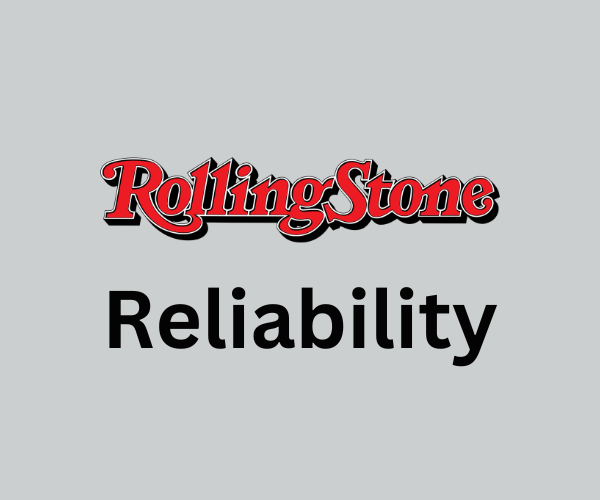
Rolling Stone has received many awards for its journalism and media. For example, in 2023, it was nominated for its first Emmy Award in the category of “Outstanding Media.” The same piece that won this title (“The DJ and the War Crimes”) also received a National Magazine Award for digital design and an Overseas Press Club Award. Also in 2023, Rolling Stone received five National Arts and Entertainment Journalism Awards (which recognizes work from U.S.-based reporters and editors), four Front Page Awards (focuses on journalistic achievement by women), and a Deadline Club Award (for outstanding journalistic performance in New York).
These accolades are indicators of well-written and comprehensive news stories; however, a substantial amount of bias remains. Several Rolling Stone’s editors have worked for or donated to Democratic politicians/candidates, and the source itself endorsed candidate Hillary Clinton in the 2016 presidential election. There has also been criticism that the magazine does not include all relevant facts of a case or repeats similar pieces of information. In 2008, conservative columnist and author Jonah Goldberg stated that the Stone had “essentially become the house organ of the Democratic National Committee.” With these elements in mind, we will investigate the reliability of contemporary Rolling Stone articles.
Does Reliability Matter?
Reliability, in general, refers to how trustworthy or accurate information, or in this case, a news source is. If we consider this definition, it quickly becomes clear why reliability is important in media sources. If we can’t trust the things we read then there isn’t much of a point in continuing to consume content from that source, after all. So how exactly can we gauge the reliability of a news source anyways?
There are several potential measures of reliability to look out for when trying to determine whether a media source is reliable or not. Red flags for an unreliable article can include the presence of wild unsubstantiated claims, facts dependent on other unreliable sources, heavy use of opinionated language, and more. Some indicators of a reliable news source, on the other hand, include things like:
- Absence of subjective/opinionated language in articles
- Credible sources cited (e.g., neutral sources, .gov, .edu websites)
- Facts and statistics backed by multiple relevant outside sources
- Use of primary sources when possible (e.g., interviews, quotes)
- Information that remains consistent across news sources
So How Does Rolling Stone Faire in its Reliability?
The political reliability index developed by Biasly objectively assesses news organizations’ accuracy and trustworthiness. Rolling Stone’s overall Reliability Score has been rated as ‘Good’ by Biasly. This rating is a weighted average of two distinct scores: the Fact Analysis Score and the Source Analysis Score, each evaluating separate components of Rolling Stone’s Reliability. When computing the Average Reliability of the article the Fact Analysis score is more heavily weighted. These ratings are as follows in the next two paragraphs:
Rolling Stone’s Fact Analysis Score is ‘Good,’ which suggests readers can trust most of its content online. The Fact Analysis score focuses more on the accuracy of claims, facts, and sources presented in the article and any hints of selection and omission bias, which we will discuss further in the article.
Rolling Stone’s Source Analysis Score is ‘Fair,’ which suggests readers can trust some of the sources, links, and quotes provided by the news source. This score, which is based on A.I., focuses on assessing the quality of sources and quotes used including their number, lengths, uniqueness, and diversity.
Other elements, such as the history of the author and context of an event, will affect the reliability of individual articles. It is important to note that each report will have a different degree of bias and credibility. Biasly finds that Rolling Stone has around as many unreliable pieces as reliable ones, which highlights the necessity for reader awareness.
We will analyze the supporting data for Rolling Stone’s ratings and describe the factors that define a trustworthy news source.
Rolling Stone Accuracy and Reliability
A news source is impacted heavily by biases that stem largely from political ideologies. Rolling Stone has been noted throughout the years to identify primarily with a liberal agenda. This sometimes clouds the reliability of their articles, as authors choose to focus on opinion rather than fact. To inspect this conclusion, we will look at selection and omission bias, as well as the evidence included in published reports.
Selection bias is when stories and facts are selected or deselected, often on ideological grounds, to create a narrative in support of the new sources’ ideology. Omission bias, on the other hand, is when different opinions and political views regarding a situation are left out so that the reader is only exposed to the ideological perspective supported by the author. It’s important to keep in mind these two types of biases when trying to assess an article’s level of accuracy.
Biasly’s percentage score assigned for accuracy is determined by distinguishing the number of reliable internal and external sources utilized, as well as the number of assertions supported with relevant evidence. Once more, the overall reliability rating for Rolling Stone is “Good,” despite its left-leaning tendencies. While this source focuses on the liberal side of the spectrum, there are others that promote a more conservative view, such as Fox 5 New York, a news station with a “Somewhat Conservative” bias and a “Fair” reliability score. Many of the articles covering national and international politics are given “Fair” scores as well, such as “Biden outlines cease-fire proposal after Israel expands ground offensive in Rafah” (Center), and “’Right to IVF Act’ blocked by Senate Republicans in latest battle” (“Somewhat Liberal”), and “Hunter Biden found guilty in gun trial” (“Moderately Conservative”). This demonstrates that bias varies despite consistent reliability scores, and highlights the importance of checking the credibility of a source.
The first Stone’s article we will look at is “Justice Alito’s Upside-Down Flag Claim Dismantled by Police, Neighbors: Report,” by Charisma Madarang. The author describes reported incidents of an upside-down American flag being flown outside of Justice Alito’s Virgninia residence, as well as alleged verbal altercations between his wife and their neighbors. Madarang references an article from The New York Times that contains recordings and text messages that support these claims, but does not include such evidence in the Stone’s piece.
“Three days later, following the inauguration of President Joe Biden, the couple drove past the Alito household. Per the couple and messages they sent to friends at the time, Martha-Ann ran toward their car, yelled something unintelligible, and as they drove past the Alitos’ residence again to exit the cul-de-sac, she appeared to spit at their car.”
Again, these messages are not included in the article, and language such as “appeared” displays subjectivity. The perspective of the neighbors, the Baden’s, is primarily focused on, displaying clear selection bias. Input from Alito and his wife is omitted, with the author portraying them negatively.
“This incident is yet another example of apparent ethical misconduct by a sitting justice, and it adds to the Court’s ongoing ethical crisis.”
This article is not listed as commentary, which poses a problem for viewers who are inclined to read the information as fact. We will observe more examples below as we investigate the credibility of Rolling Stone.
Analysis of Reliability in Rolling Stones Opinion Pieces
Opinion pieces express a mode of journalism that allows reporters to share their personal values and beliefs; however, it can become dangerous when speculation is not separated from fact. Due to its subjectivity, commentary is typically less reliable and reflects one side of a political issue. Rolling Stone has been known to publish a substantial number of opinion pieces, even if not directly labeled, that support liberal ideologies and officials. The news source has made its support for Democratic values and candidates known, which is apparent in their articles. Another problem lies within their organization, as there is not a distinctive commentary column. Certain pieces are labeled as opinion, whereas others are filed under different categories yet remain largely subjective in nature. Many of their recent pieces have aimed to condemn presidential candidate Donald Trump or other Republican officials.
For example, the article “Trump Rambles Through Grievances in Trainwreck Post-Conviction Speech” by Nikki Mccann Ramirez and Catherina Giono consistently portrays the Republican Party negatively. Comments from individuals on both sides of the political spectrum are included, but the article contains a strong left-leaning bias. This detracts from its overall reliability, despite the substantial number and length of quotes.
Quality of Sources and Facts Used
Next, let’s analyze “The Most Ridiculous, Right-Wing Supreme Court That Dark Money Could Buy,” by Andrew Perez. There are only five quotes used in this piece, which are broken down as follows: one long quote, one medium quote, and three short quotes. The sources of the quotes are listed below.
- Leonard Leo, Donald Trump’s judicial advisor (Republican)
- Lisa Graves, executive director of True North Research (investigative research organization)
- Republican Speaker Mike Johnson
- 2024 Presidential candidate Donald Trump (Republican)
- A “lawyer close to Donald Trump”
The majority of quotes coming from Republican individuals is misleading at first glance. Quotes chosen from these officials don’t adequately represent the conservative perspective and do not serve to explain opinions on the right side of the political spectrum. The bias of the article is evident throughout its entirety, from its title and dramatic subheading, to the intense conclusion.
“The high court’s conservative supermajority is in your body, helping elect Trump, and in-your-face corrupt. No one is going to stop them.”
“The potential for destruction would be immense. The justices and their dark money allies are ready to seize their opportunity and take full advantage of it.”
The information provided is extremely vague, failing to point to detailed or objective facts to adequately explain recent legislation. This is an interesting example because, again, while more quotes are listed from conservative sources, the attitude in the article is overwhelmingly liberal. Republican opinions are almost entirely omitted, and the author selects examples that support left-leaning perspectives.
This piece references other Rolling Stone articles, the New York Times, Judicial Crisis Network (JCN), The Lever, ProPublica, The Washington Post, Navigator Research, Roll Call, NPR, SCOTUSblog, Chicago Tribune, X, and Axios. Most of these sources (not including SCOTUSblog) are left-leaning, with the exception of the Judicial Crisis Network and Chicago Tribune, which leans right. While many outside sources are mentioned, a majority favor liberal viewpoints. The lack of opposite sources and viewpoints hurts the article’s reliability and argument.
There is also clear selection and omission bias found in a previously discussed article, “Trump Rambles Through Grievances in Trainwreck Post-Conviction Speech.” The authors select language that encourages an unfavorable opinion of conservative individuals. This is especially true of Donald Trump, seen through quotes such as:
“During the lengthy, rambling address, Trump unloaded a stream-of-consciousness laundry list of grievances ranging from the trial itself, to his issues with the Jan. 6 Committee, to the border.”
Again, while the article contains quotes from both Democratic and Republican citizens, the left-leaning sway undermines the reliability of the piece. The only other sources referenced are other Rolling Stone articles and posts on X (some of which were originally posted by Ramirez, one of the authors). With that said, it is pertinent for readers to exercise caution when distinguishing between fact and opinion.
Selection and Omission Bias
Another article that demonstrates selection and omission bias is “Will Democrats Do Anything About the Supreme Court Ethics Crisis?” by Ryan Bort. The author attempts to describe the current predicaments surrounding the Supreme Court, specifically the contention between Democratic justices and Republican Justice Samuel Alito. Opinions are selected that favor liberal viewpoints, and Bort omits input from those with a right-leaning ideology. His opinion is plainly expressed through included quotes and emotional language.
“The MAGA Republican judicial project seeks to bring America backwards. We cannot let them win” (Democratic Representative Richie Torres).
Bort continues to fuel this divide with other subjective comments. For example, when referencing a vote to implement a code of ethics in the Supreme Court, he states:
“Republicans are of course not going to do this, which means the vote is essentially a stunt designed to get Republicans on the record as opposing something everyone already knows they oppose.”
The language utilized is inimical to the Republican Party, and there is a lack of perspectives from conservatives that cause issues with selection and omission. Bort also neglects to include a transcript of the audio that is connected to Justice Alito. The only outside sources referenced here are X posts and other Stone articles. As seen with prior articles as well, right-wing viewpoints are either largely omitted, or are not reported objectively. This creates unbalanced accounts of the events being expressed by the authors. The liberal-leaning tendency of these articles represents a greater trend within the organization.
So is Rolling Stone Reliable?
Rolling Stone is a low-credibility news source, with many of its articles containing opinion writing rather than factual analysis. A general omission of conservative views, the lack of detailed reporting, and its subjective nature contribute to the Stone’s faltering reliability. However, it must be remembered that individual articles are subject to varying levels of bias and trustworthiness. If readers need assistance in determining the credibility of an article, they can use Biasly’s New Bias Checker.























